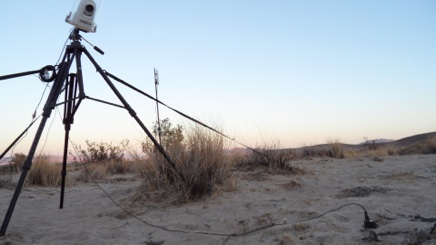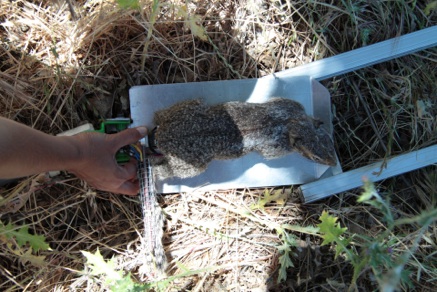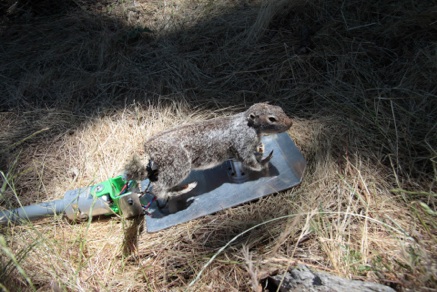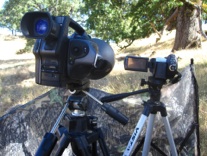METHODS
Studying free-ranging animals in nature is difficult. It requires patience, experience, dedication, and resilience. Every species or system will have specific problems that require novel solutions. In our case, we needed to come up with ways that we could first observe natural interactions between rattlesnakes and small mammals, and then invent ways in which we could manipulate those interactions to experimentally test specific hypotheses about how they work.
FIELD SITES
Our research on ground squirrels and Northern Pacific rattlesnakes takes place at the Blue Oak Ranch Reserve (BORR), one of the several field stations maintained by the University of California Natural Reserve System. The director of BORR, Dr. Michael Hamilton, is an expert on the use of technology in ecological monitoring; much of BORR is covered by a wireless network that is instrumental in our use of videography.
Our research on kangaroo rats and sidewinder rattlesnakes is conducted at the Desert Studies Center (DSC). This field station in the Mojave Desert provides the basic facilities and support necessary for our crew to work at night. We took what we learned about field-based wireless equipment from BORR and have used it to construct a wireless network at DSC.
RADIO TELEMETRY
The first step is to locate the rattlesnake predators, and implant small radio transmitters into their body cavities so we can follow them around the field. Rattlesnakes are very secretive and cryptic; without radio telemetry, we wouldn’t be able to relocate a snake once it was released back into the wild. But with radio telemetry, once we find a snake, we can relocate it at will to observe its behavior and record any interactions with potential prey animals.
SMALL MAMMAL TRAPPING
After we have started following rattlesnakes, we attempt to trap and mark all of the focal small mammals (ground squirrels or kangaroo rats) that live where the snakes are hunting. We use ear clips and fur dye to mark each small mammal uniquely, so that we can examine how different individuals react to snakes, and we can conduct experiments with multiple individuals of each species.
WIRELESS VIDEO SYSTEMS
When it comes to documenting rattlesnake behavior in the wild, there is one fundamental problem to overcome: snakes are extremely low-energy ambush predators that feed (and do everything else) infrequently. Researchers can often observe endotherms, such as birds or squirrels, from blinds and record lots of data on their behavior. We have found that it’s basically impossible to do this with snakes. For one thing, rattlesnakes interact with prey so infrequently that it would require many observers to watch enough snakes to get enough data for analysis. But even if you have many researchers, humans don’t make good snake watchers. We’re too impatient, and our metabolisms are too high. Even if you did have the patience to sit day and night for hours on end, watching a coiled rattlesnake do nothing, eventually you’d have to take a break. In the 5 second window when you look away, a kangaroo rat runs by, gets bitten by the snake, and then runs off. You look back and don’t realize you missed the whole thing.
Our solution to this problem has been to take advantage of the sedentary nature of the rattlesnake’s foraging strategy and use video recorders to study behavior. We have constructed a field-based wireless video observation system, using relatively inexpensive electronic components available from the security industry. Our video system consists of battery-powered security cameras hooked up to wireless radios (we use Nanostaion M2s) that are all communicate via a local area network. One or two people on the field crew can monitor the video feeds from up to a dozen cameras which are all recording snakes that are hunting small mammals from ambush. The video monitors can alert other members of the field crew when a snake leaves, or a camera needs to be repositioned. We can also review these recordings in detail at a later date to extract data on snake and small mammal behavior.
BIOROBOTICS
The displays exhibited by small mammals towards snakes are a form of communication. Researchers who want to know what animal signals mean have to conduct “playback” experiments. That is, we have to be able to recreate a version of the signal that we can manipulate in a controlled fashion. This is the only way to figure out how potential receivers of that signal might respond under different conditions, or to specific variants of the signal.
Playbacks are fairly straightforward for some types of signals, like auditory calls and songs, but they can be tricky with complex three-dimensional visual displays. In the past decade, animal behaviorists have increasingly turned toward the use of biorobotics: relatively simple model animals that contain some sort of robotic or mechanical components. These models are usually very inexpensive (see FUNDING), and can be surprisingly effective. Past studies have effectively recreated playback displays of tree squirrels, fish, rats, cockroaches, frogs, birds, and others (see BIBLIOGRAPHY).
Our own forays into the use of biorobotics started with the research by Rundus et al. (2007) in constructing a biorobotic ground squirrel. We have modified and tested this model several times to develop a field-ready version. We are also constructing a biorobotic kangaroo rat that will use a solenoid piston to recreate a playback of the kangaroo rat foot thumping display.
OTHER METHODS
We employ a number of other novel field methods as well. We use plaster models of snakes to elicit antipredator displays from squirrels; we monitor pulse rates in our temperature-sensitive transmitters to document temperature profiles of snakes; we are developing a spring-based trap to simulate snake attacks in staged squirrel behaviors; we use geophones to record vibrations and foot drumming signals of kangaroo rats. Our field project is typical of many behavior and ecology field projects: when you’re asking inventive new questions about nature, you usually have to come up with inventive new methods that will push you forward.












